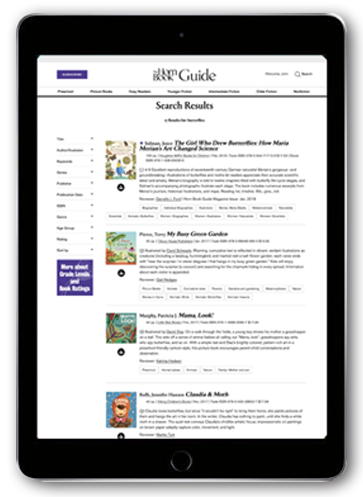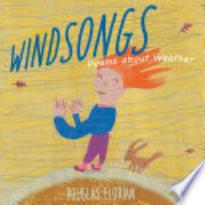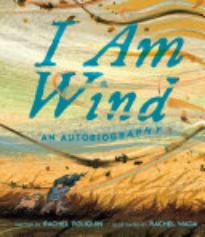Earth science--Meteorology
70 Reviews
(2)
K-3
Kids are often hyper-aware of such natural phenomena as thunder, lightning, and snow, so a collection of twenty engaging, informative poems about weather is likely to be a hit. Here topics include the familiar (e.g., sun, hurricanes, hail, and wind) as well as less commonly featured subjects, including atmosphere, weather instruments, and the work of a meteorologist. Using a variety of poetic forms, Florian (Zoobilations!, rev. 3/22, and many others) provides nuggets of facts embedded in playful rhymes, often with surprise endings or a humorous slant. The poems are notable for their strong rhythms, pleasing repetition, and clever wordplay. From "Fog," for example: "It drifted down, / close to the ground, / then napped beside a hill. / And gave the day / ten shades of gray, / each un-fog-ettable." Rendered in "gouache paint, colored pencils, and rubber stamps on primed paper bags," every fanciful full-bleed illustration is paired with a poem on the facing page, giving each double-page spread an open and inviting feel. A helpful glossary provides more information about the topics, and a list of weather websites for kids and suggested further reading complete the excellent back matter.
(2)
4-6
Illustrated by
Rachel Wada.
This innovative collection of musings on wind mixes poetic expression, cultural myths, and scientific facts to describe and explain wind phenomena. Major topics include the ways winds are formed in dynamic environments such as mountains, coasts, and deserts; human interactions with wind, from experiencing a breeze to harnessing wind power; global wind patterns; and the power of cyclones, tornadoes, and erosive processes. The wind itself emotes throughout the book, using expressive language to describe, for example, the aftermath of the hot winds (called Loo) of the Himalayas: "And I think to myself, if I had not burnt the land, you would not be so happy to see the flowers and birds return." Sections labeled "Wind Chronicles" are interspersed with the main text and relate folkloric origin stories and historical accounts of major wind events. Wada's mixed-media illustrations echo the emotions in the text, swirling color and linear elements to depict the flow of wind and the movement of objects in its wake. Back matter includes an index of key terms and suggestions for further reading.
Reviewer: Danielle J. Ford
| Horn Book Magazine Issue:
January, 2025
(2)
K-3
Illustrated by
David Litchfield.
"Around the world, when morning comes...the sky glows." But it also glows at times beyond sunrise and sunset, as Beckerman explains in four-page sequences that build anticipation for each new example. A crowd of upturned faces wearing protective eyewear gives way to a double-page spread of the eerie glow just before a solar eclipse; a pair of hikers in the fading light of day walks into the stunning synchronized light show produced by fireflies in the Great Smoky Mountains National Park. The main text, with its repeated refrain ("the sky glows") is brief and poetic, while longer secondary text in smaller type provides explanations of the featured phenomena, which include aurorae, rainbows, volcano eruptions, and city lights at night. Litchfield's arresting illustrations convincingly convey the look and feel of a glowing sky, through skillful use of warm yellows, reds, and oranges, and scattered star-like sparkles. A brief end note introduces the concept of light pollution, and a list of further reading is included.
Reviewer: Danielle J. Ford
| Horn Book Magazine Issue:
November, 2022
Nickel, Sandra
Breaking Through the Clouds: The Sometimes Turbulent Life of Meteorologist Joanne Simpson
(3)
Illustrated by
Helena Perez Garcia.
Starting with her abusive home life, this lyrical picture-book biography of a pathbreaking woman meteorologist explains the pervasive sexism she faced getting an education during the 1940s and conducting her revolutionary research into cumulonimbus clouds. Due to her persistence, a previously dismissive male mentor had a change of heart and gave her computer time to build a mathematical model of cloud motion that "sparked an entire branch of science." Full-bleed illustrations in muted pastels straddle the literal and metaphorical (an illustration of her receiving her doctorate has her "flying higher than the clouds themselves"); an author's note, bibliography, timeline, and three archival black-and-white photos relay further facts.
Reviewer: Anita L. Burkam
(4)
K-3
Super Simple Earth Investigations series.
After a brief introduction to each earth science topic, readers are provided with instructions for activities that demonstrate the concepts. The activities vary in quality: some capture the science well and prompt good questions, others are merely art projects with few connections to the underlying science. Photographs of children engaged in each step of the activities are helpful. A quiz is included. Glos. Review covers these Super Simple Earth Investigations titles: Super Simple Earthquake Projects, Super Simple Fossil Projects, Super Simple Mineral Projects, Super Simple Rock Cycle Projects, Super Simple Volcano Projects, and Super Simple Weather Projects.
Reviewer: Danielle J. Ford
(3)
K-3
John Jeffries, a loyalist who moved to England after the Revolutionary War, became the first American to study weather conditions in a hot-air balloon, as well as to cross the English Channel in one (with copilot Jean-Pierre Blanchard). Brown relates the story with humor and woven-in (sourced) quotations. Pencil and watercolor illustrations vary in perspective and add cartoonish wit. Bib.
(4)
K-3
Our Extreme Earth series.
These small-trim books for very young readers present basic introductions to earth science topics. A sentence or two on each page defines processes or materials, with emphasis on key vocabulary words. Colorful (uncaptioned) photographs are fairly well matched to the accompanying text. Each book ends with an image and brief profile of a scientist from the related field and a question for further thought. Glos. Review covers these SandCastle: Our Extreme Earth titles: Earthquakes, Fossils, Minerals, The Rock Cycle, Weather, and Volcanoes.
Reviewer: Danielle J. Ford
(4)
1-3
My Weirdest School series.
Illustrated by
Jim Paillot.
In Newman, high jinks ensue when a local meteorologist takes A.J. and Andrea on a hot-air balloon ride and the trio gets caught in a sandstorm. In Tracy, a retired astronomer directs a student play about the solar system, and A.J. is given the unfortunate role of Uranus. Despite repetitive, one-note humor, series fans will enjoy the over-the-top wackiness complemented by black-and-white cartoons. Review covers these My Weirdest School titles: Miss Newman Isn't Human! and Miss Tracy is Spacey.
Reviewer: Russell Perry
(3)
K-3
Stunning art--photographs of paper dioramas in which two children and a caregiver sail through and frolic beside luminous seascapes--adds a narrative element to this collection of weather lore. Historical weather-prediction sayings in rhyme are each based on observations in nature: "Ring around the moon, rain will come soon. / Red sky in the morning, sailors take warning!" Back matter explains each bit of "Weather Wisdom." Bib.
Reviewer: Sheila M. Geraty
(4)
K-3
Earth Detectives series.
Olson's cursory introductions to different earth-science disciplines first define each field, then shift to discussions of the scientific research and methods used. One famous historical scientist is always profiled, then the laboratory and field work of today's practitioners are described; accompanying photographs feature the landforms and earth materials discussed plus important scientific tools. Back matter offers career advice and tests readers' comprehension. Glos. Review covers these Earth Detectives titles: Exploring Earthquakes, Exploring Fossils, Exploring Minerals, Exploring the Rock Cycle, Exploring Volcanoes, and Exploring Weather.
Reviewer: Danielle J. Ford
(2)
4-6
Scientists in the Field series.
Cherrix introduces and personalizes the work of scientists on Wallops Island, Virginia, trying to understand and forecast a storm's intensity to offer maximum time for residents to evacuate. The text provides clear and informative background; biographical information on a variety of scientists, ranging from meteorologists to aeronautical engineers, creates a number of entry points for potential readers. Reading list, websites. Bib., glos., ind.
Reviewer: Betty Carter
| Horn Book Magazine Issue:
July, 2017
(3)
4-6
Illustrated by
Theo Cobb.
Vicki Cobb begins with in-depth discussions of the physical science underlying hurricane development and formation (air pressure, states of matter, and energy). She then turns to the technology used to model hurricane formation and the research that investigates the possibility--and potential downside--of tinkering with hurricanes to minimize their impact on developed areas. Many quality photographs and illustrated diagrams are included. Websites. Bib., glos., ind.
Reviewer: Danielle J. Ford
(4)
K-3
X-Books: Weather series.
These somewhat scattershot but browsable volumes combine history and meteorology with maps, statistics, and embellished photographs. Each book contains a countdown of the "Top Five Xtreme" examples of the weather phenomenon (or meteorological tool in Forecasting), with explanations of the science behind them. Cluttered layouts and occasional difficult-to-read spiral and vertical text detract from the information-packed presentations. Bib., glos., ind. Review covers these X-Books: Weather titles: Clouds, Forecasting, Hurricanes, Snow, Thunderstorms, and Tornadoes.
Reviewer: Renée Wheeler
(2)
K-3
Illustrated by
William Grill.
This haiku collection about Earth's geological and meteorological features combines correct terminology with a wry, child-friendly sensibility. Colored-pencil pictures are informal and sketchlike in some places and painterly in others, giving a sense of the places and action. Tiny jewels of poetry and oversize pictures will draw children into contemplating natural wonders. Symbols at the bottom of each illustration are explained in an appended section. Reading list.
Reviewer: Susan Dove Lempke
| Horn Book Magazine Issue:
January, 2018
(4)
K-3
Illustrated by
Lissy Marlin.
Mira is the psychic-abilities-lacking daughter of boardwalk fortune-teller Madame Mirabella. But when her mom gives her a pinwheel and a windsock, Mira learns that she can forecast, if nothing else, the weather. (Six weather terms are defined mid-story.) Things proceed predictably--Mira averts disaster during her town's annual surf competition--but not unpleasantly, with an assist from the lively digital art.
Reviewer: Nell Beram
(4)
4-6
Stickmen's Guides to This Incredible Earth series.
Illustrated by
John Paul de Quay.
In this series, stick figures travel through the layers of our planet's atmosphere, earth, and sea. In places such as the troposphere, grasslands, and sunlight zone, the stickmen skim over physical science principles, plant and animal life, and human activities (e.g., space exploration, mining). Beneath the unnecessary stick-figure gimmick are helpful information and diagrams in a neatly organized presentation, though the tiny type is off-putting. Glos., ind. Review covers the following Stickmen's Guides to This Incredible Earth titles: Stickmen's Guide to Earth's Atmosphere in Layers, Stickmen's Guide to Mountains and Valleys in Layers, and Stickmen's Guide to Oceans in Layers.
Reviewer: Danielle J. Ford
(3)
4-6
STEM in the Real World series.
This series entry surveys careers in the field of meterology, doing weather prediction, modeling, and even storm chasing. The text also discusses educational requirements; the history of weather prediction, emphasizing the technologies in use over centuries of observation; and the future use of drones, advanced computing, and satellites. Color photographs, first-person quotes, and sidebar activities that emphasize nonfiction literacy are included. Reading list. Glos., ind.
Reviewer: Danielle J. Ford
(2)
K-3
Illustrated by
Sebastià Serra.
This exploration of the evolution of weather, atmosphere, and climate sciences interweaves accounts of historical beliefs with current understandings. In the telling, Kudlinski emphasizes the important scientific practices of learning from mistakes and drawing on many different sources of evidence to develop knowledge. Cartoonlike digital and pencil illustrations feature children and adults experiencing weather in modern and historical contexts. Timeline, websites.
Reviewer: Danielle J. Ford
| Horn Book Magazine Issue:
July, 2015
(4)
K-3
Cloverleaf Books: Nature's Patterns series.
Illustrated by
Holli Conger.
Ms. Ling's class solves mysteries involving missing ice and disappearing puddles. Mr. Davis's class observes wind and temperature patterns to learn about forecasting. Though the fictional stories are slight and the illustrations cartoony, both books present accessible introductions to their topics and to using the scientific method. A related activity is appended. Reading list, websites. Glos., ind. Review covers these Cloverleaf Books: Nature's Patterns titles: When Will it Rain? and Why do Puddles Disappear?.
Reviewer: Paula M. Cairo
(4)
K-3
Let's-Read-and-Find-Out Science series.
Illustrated by
Taia Morley.
After explaining how hurricanes form, this volume explores the role of scientists tracking hurricanes and gives a toned-down description of conditions when a hurricane makes landfall. Although a few of the simplifications may cause confusion, the clear layout; dynamic, full-bleed, digitally enhanced watercolor illustrations; and plain, reassuring language will help readers understand this dramatic type of weather. Activities appended. Websites. Glos.
Reviewer: Anita L. Burkam
70 reviews
We are currently offering this content for free. Sign up now to activate your personal profile, where you can save articles for future viewing.























